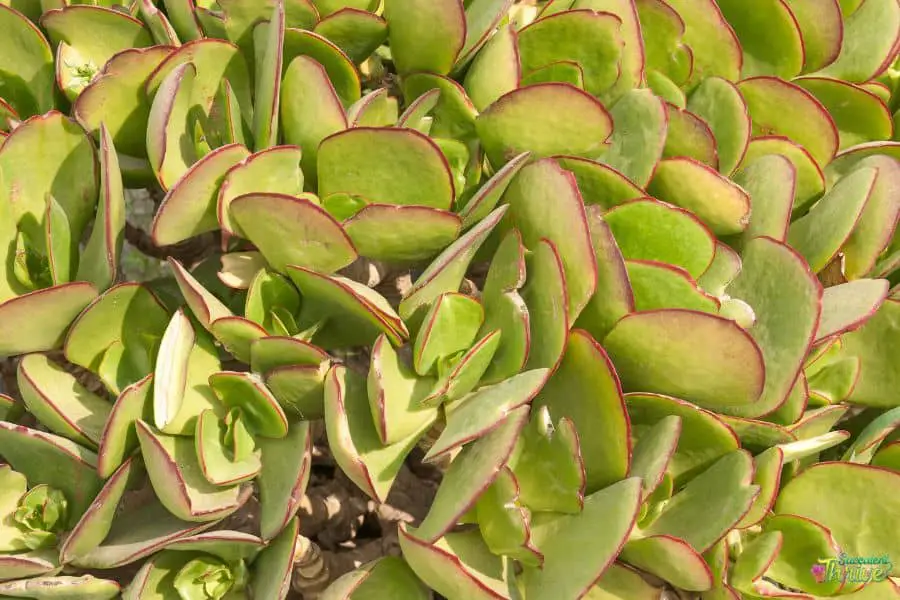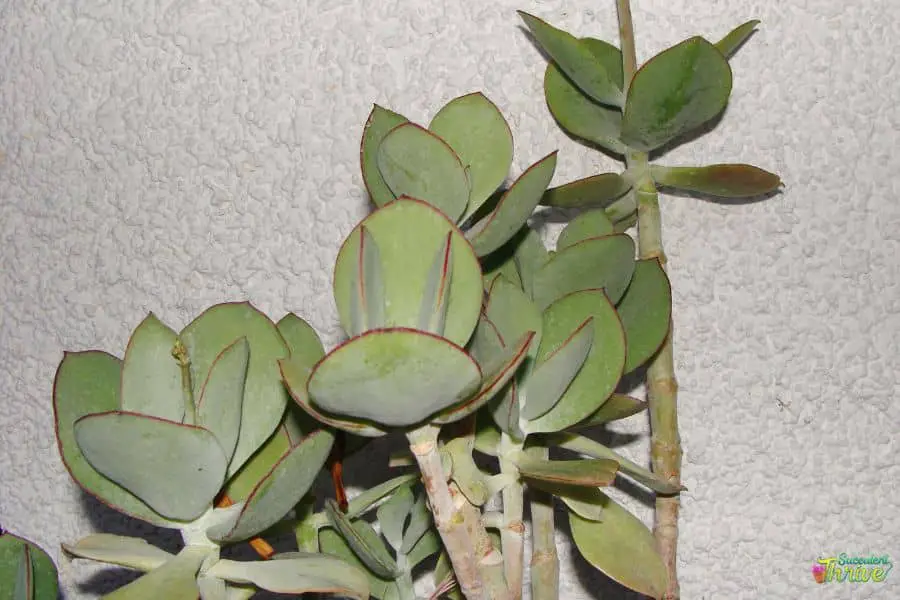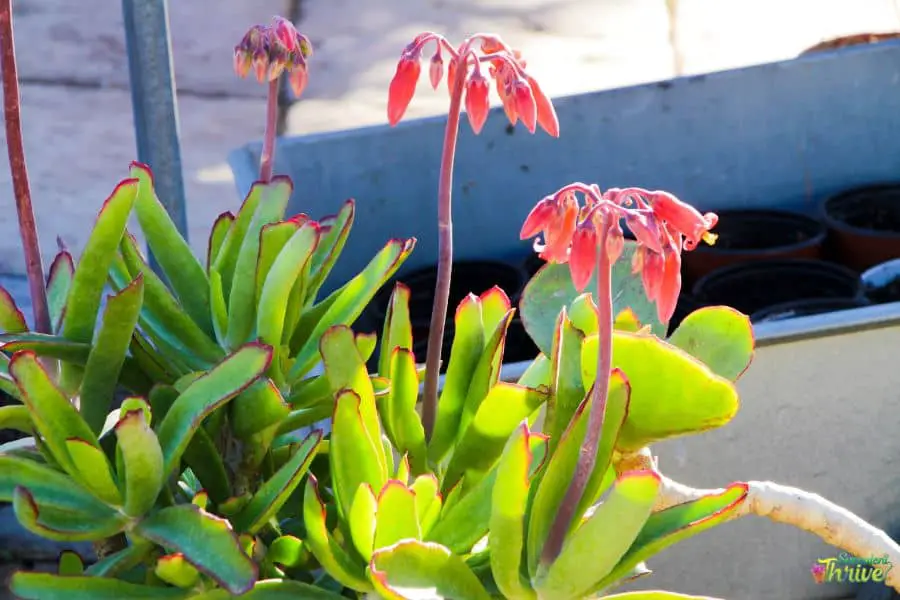Cotyledon orbiculata propagation is easy and can be done by using cuttings, offsets, and seeds as well. You need very few things to propagate this plant, and in this article I am going to explain how I do Cotyledon orbiculata propagation at home.
This unique plant has spoon-shaped leaves, and it is endemic to Namibia and southwest Africa. I’ve seen them grow upright, but they prefer to be shrubs when they’re young. As they mature, they can grow taller. Once you expose the plants to adequate sunlight, it will make the leaves’ edges red. You may also notice a layer of white powdery dust forming on the surface.
The distinguishing feature of these plants is that they would bloom with orange-red flowers. So, if you are excited to own a Cotyledon orbiculata plant and are wondering how to make new plants out of this, you will find this article quite useful. We will be covering how to propagate the plants from cuttings, offsets, etc. and giving you an in-depth, step-by-step description of how to conduct it.

Cotyledon orbiculata propagation by cuttings
If you wish to propagate the Cotyledon orbiculata plants by using cuttings, the first thing you need to do is disinfect the tools that are used to do this task. Ideally, you need to use a clean knife or a sterile pair of scissors to snip off the cuttings. Once you use disinfected tools, they will not contaminate the specimen. Once you snip off the cuttings, you need to allow them to dry for a couple of days. Next, place the cuttings in an appropriate soil mix. Maintain constant moisture in their soil whenever it becomes dry.
Cotyledon orbiculata propagation by leaf
Propagating the Cotyledon orbiculata plants using their leaves is quite simple. First, you need to obtain a healthy leaf from the mother plant. However, when you obtain the leaf, ensure that you are taking the whole leaf without leaving any part of it on the mother plant. If you end up using damaged, unhealthy leaves, it will not give you successful results in the propagation process. As the next step, you should place them in a warm, dry place where the cut edges can become callous. After that, plant them in a suitable soil mix and water them whenever you notice their soil is dry.

Do they produce seeds?
Cotyledon orbiculata plants develop a seed item, and you could use those seeds for propagation as well. Having said that, these plants are slow-growing, and it is very unlikely that you could spot them developing roots. As a result, I do not recommend using this propagation method. However, if you desire to proceed with this option, you can simply lay the seeds in a well-draining soil mix and watch them flourish. Once you spot them as seedlings, you can consider replanting them in individual pots. In addition, you should use this method for outdoor-grown plants.
Do they produce offsets?
Cotyledon orbiculata plants offset quite easily. So, using offset propagation is a simple way to propagate Cotyledon orbiculata plants. In fact, offset propagation is the most common method of propagating these plants.
So, if you want to try the offset propagation method, you should first use a sharp knife to separate the offset from the main plant. Once you separate the offsets, you need to first remove the extra soil around their roots. Ensure that you do this step, as the older soil around the roots of these offsets doesn’t carry any nutrients, and it would be best to get rid of them.
After that, you should place some newspapers in the pot. Once you add a newspaper layer, it will prevent any soil from spilling from the pot. Next, you can plant the offsets while filling the pot with substrate. Gently place offsets in the pot and make sure they are well stabilized there. Apply some water and make the soil moist. Finally, to hasten growth, place the specimen in a well-lit area and lightly mist it.

Can you root the Cotyledon orbiculata in water?
You can propagate Cotyledon orbiculata plants in water. First, you need to obtain cuttings that are 2-4 inches long and ensure those cuttings comprise a couple of leaves as well. Next, you need to allow them to develop calluses, as if you use cuttings that are not calloused, they will not give you the best results. In terms of selecting the best vessel, I would say a glass jar or any other clear jar would suit this purpose. That way, you could see what was happening inside the specimen. In addition to that, it would allow the cuttings to absorb sufficient sunlight, too.
Next, place the cuttings in a jar filled with water. Ensure that the cuttings do not come into contact with the water layer, as this could cause rot. After you have completed all of these steps, you can place the specimen in a location where the plants will receive bright indirect sunlight. You could spot them sprouting in about 2–6 weeks’ time, which could vary depending on the environmental conditions.
How to treat after propagation
Light requirement of the Cotyledon orbiculata plants
Succulents in general and Cotyledon orbiculata plants are the same. So, you need to allow the plants to gain five to six hours of sunlight on a daily basis, preferably in the early morning hours. When you cultivate them as houseplants, you can place them closer to a bright, sunny windowsill. However, you need to safeguard the plants from intense sunlight.
Soil requirement of Cotyledon orbiculata plants
A gritty soil mix that consists of about 75 percent mineral components would work well with these plants. Avoid using substances such as peat moss or clay, as they would retain more water within the soil mix and make it soggy. Ultimately, it would lead to rot. I recommend that you use soil mixes designed specifically for succulents and cacti because they will fit in perfectly with these plants.
In addition to this, ensure that you are using a pot which has a couple of draining holes. Furthermore, I recommend you use either a terracotta pot or a clay pot as they would be perfect fits for these plants.

Water requirement of the Cotyledon orbiculata plants
Remember, Cotyledon orbiculata plants are succulents, which literally means they would thrive well with minimum watering. So, you can water them occasionally whenever their soil is dry. A small piece of advice from me is to always water the plants only if their soil is dry. Usually, you can water them once every one to two weeks during the spring and summer. When you water them, water them thoroughly. When you notice the excess water draining, you can stop watering them further.
Cotyledon orbiculata plants temperature and humidity care
Cotyledon orbiculata plants are adapted to grow in temperatures around 70 degrees Fahrenheit (21 degrees Celsius) during the daytime. Furthermore, they can tolerate temperatures ranging from 60 to 65 degrees Fahrenheit at night. Cotyledon orbiculata plants are somewhat cold-hardy given that you don’t expose them to drastic changes in temperatures.
If you are experiencing much colder conditions, you need to cultivate them as houseplants. If you grow them indoors, you must supplement the light with artificial lights if the natural light is insufficient. Make sure that you are exposing the plants to 50 percent to 70 percent humidity levels, as those conditions would suit them the best. If you expose the plants to higher humidity levels, it will make the plants rot.
Fertilizer requirement of Cotyledon orbiculata plants
Cotyledon orbiculata plants would prefer to have a light feeding when they are actively growing. Late spring or early summer is the best time to feed these plants. Further, a slow-release organic fertilizer would be perfect for this task. Refrain from feeding the plants when they are dormant.
Final thoughts
I hope you found this article informative and that you are all set to start propagating these plants. Further, I trust that now you are well equipped with the relevant knowledge on how to care for them and nurture them after propagation, too.
Read Next : How Succulents Reproduce? (It’s Easier Than You Think)
Read Next : Echeveria Nodulosa Propagation | 4 Effective Methods |
